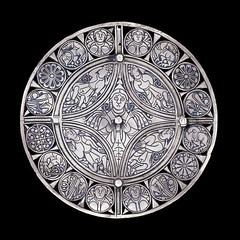I would like to compile a bibliography of medieval art. In part it serves as a wish list, in case I ever win the lottery. This is a start, these works are surveys of the entire Medieval period. The only ones I am familiar with are the Calkins, which I own; the 1st edition of the Snyder, which was my Medieval Art textbook at OU; and the Stokstad which I have seen in the library. I quick look via Google at a few syllabuses for Medieval Art surveys seems to show the Snyder and Stokstad are the two most common textbooks in use. I hope to get my hands on the all of these in the near future. I f I do so, I may repost an annotated version of this.
Benton, Janetta Rebold,
Art of the Middle Ages
, New York, N.Y. : Thames & Hudson, 2002.
Calkins, Robert G.,
Monuments of Medieval Art
. Ithaca : Cornell University Press, [1985?], c1979.
Focillon, Henri, (trans. Donald King).
The Art of the West in the Middle Ages, 2 Volumes.
London, New York, Phaidon, 1969.
Kessler, Herbert L,
Seeing Medieval Art
, Peterborough, Ont. ; Orchard Park, NY : Broadview Press, c2004.
Lacroix, Paul.
Arts In the Middle Ages and the Renaissance
. New York, F. Ungar Pub. Co. [1964]
Lethaby, William Richard,
Medieval Art From the Peace of the Church to the Eve of the Renaissance, 312-1350.
, London, Duckworth and co., New York, C. Scribner’s sons, 1904.
Luttikhuizen, Henry and Dorothy Verkerk, eds.,
Snyder's Medieval Art
, Second Edition, Upper Saddle River, NJ : Prentice Hall, 2006.
Morey Charles Rufus,
Mediaeval Art
New York, W. W. Norton & company, inc. [1942]
Reber, Franz von,
History of Mediaeval Art
, New York, Harper & brothers, 1887.
Sekules, Veronica,
Medieval Art
, Oxford : Oxford University Press, 2001.
Snyder, James;
Medieval Art: Painting, Sculpture, Architecture 4th-14th Century ;
; New York : H.N. Abrams, 1989; Upper Saddle River, NJ : Prentice Hall, 2006.
Stokstad, Marilyn,
Medieval Art , 2nd ed.,
, 2nd ed., Boulder, Colo. : Westview Press, c2004.
Zarnecki, George,
Art of the Medieval World, Architecture, Sculpture, Painting, the Sacred Arts
, Englewood Cliffs, N.J. : Prentice-Hall, 1975.





 This is a page from the Escorial Beatus (Escorial, Biblioteca Monasterio, Cod. & II. 5). Beatus of Liébana was an 8th century monk who wrote a commentary on the Book of Revelation. Actually "wrote" is a bit of strong word, as what he actually did was compile a bunch of other writer's comments together. For some reason his Commentary became a very popular book in the 9th and 10th centuries. There are twenty some copies extant, most of which are lavishly illustrated, often with full page miniatures. The Beatus manuscripts are an important part of what is called Mozarabic Art. There existed in the Christian kingdoms of the Iberian peninsula a tradition of manuscript illustration that was unlike anything else be doing anywhere else in Europe. This tradition emphasized flat, stylized forms for the human bodies. The drapery of the clothes was portrayed as abstract patterns that gave little indication of a body beneath. There was a strong, almost garish sense of color with vivid yellows, greens and reds dominating. The iconography was often startlingly original. It seemed almost as if the entire tradition of book illumination had to be invented anew.
This is a page from the Escorial Beatus (Escorial, Biblioteca Monasterio, Cod. & II. 5). Beatus of Liébana was an 8th century monk who wrote a commentary on the Book of Revelation. Actually "wrote" is a bit of strong word, as what he actually did was compile a bunch of other writer's comments together. For some reason his Commentary became a very popular book in the 9th and 10th centuries. There are twenty some copies extant, most of which are lavishly illustrated, often with full page miniatures. The Beatus manuscripts are an important part of what is called Mozarabic Art. There existed in the Christian kingdoms of the Iberian peninsula a tradition of manuscript illustration that was unlike anything else be doing anywhere else in Europe. This tradition emphasized flat, stylized forms for the human bodies. The drapery of the clothes was portrayed as abstract patterns that gave little indication of a body beneath. There was a strong, almost garish sense of color with vivid yellows, greens and reds dominating. The iconography was often startlingly original. It seemed almost as if the entire tradition of book illumination had to be invented anew.